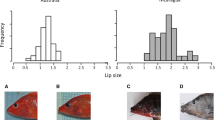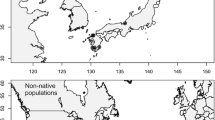Abstract
Populations can respond to environmental heterogeneity by genetic adaptation to local conditions. Evidence for local adaptation in herbivores with relatively broad host breadth is scarce, either because generalists rarely locally adapt or because fewer studies have tested for local adaptation. The marine isopod Idotea balthica, a small (<3 cm) generalist herbivore common to estuaries of the northwestern Atlantic, is found on multiple macroalgae and sea grasses north of 42°N, while more southerly populations utilize sea grass-dominated and macroalgal-poor habitats. Feeding preference assays revealed a latitudinal shift in preference hierarchy that mirrors this geographic variation in host availability. Northern populations have higher feeding preference for fresh and freeze-dried tissue of the brown macroalga Fucus vesiculosus and consumed more of its water-soluble and lipophilic extracts relative to southern populations. In contrast, southern populations have a relatively higher preference for the green macroalga Ulva linza and sea grass Zostera marina. The rank of hosts in feeding assays exhibited by northern adults (Fucus = Ulva > Zostera) and southern adults (Ulva > Fucus > Zostera) closely mirrored ranking of juvenile growth rates, suggesting that preference and performance are strongly correlated across these macrophytes. Several of our assays included isopods that had parents reared under uniform laboratory conditions, indicating that geographic differences are genetically mediated and unlikely to reflect phenotypic plasticity or maternal effects. Local adaptation in host use traits may be common in broadly distributed, generalist herbivores in marine and terrestrial systems, and will manifest itself as local shifts in the preference ranking of hosts.





Similar content being viewed by others
References
Abramoff MD, Magelhaes PJ, Ram SJ (2004) Image processing with ImageJ. Biophotonics Int 11:36–42
Arnold TM, Targett NM (2003) To grow and defend: lack of tradeoffs for brown algal phlorotannins. Oikos 100:406–408
Bell TM (2009) Defining mechanisms for the maintenance of genetic diversity in the North Atlantic isopod, Idotea balthica. PhD dissertation, University of Georgia, Athens, Georgia
Bertness MD (2007) Atlantic shorelines: natural history and ecology. Princeton University Press, Princeton
Bolnick DI, Svanbäck R, Fordyce JA, Yang LH, Davis JM, Hulsey CD, Forister ML (2003) The ecology of individuals: incidence and implications of individual specialization. Am Nat 161:1–28
Conover DO (1998) Local adaptation in marine fishes: evidence and implications for stock enhancement. Bull Mar Sci 62:477–493
Coyne JA, Orr HA (2004) Speciation. Sinauer, Sunderland
Craig TP, Itami JK, Price PW (1989) A strong relationship between oviposition preference and larval performance in a shoot-galling sawfly. Ecology 70:1691–1699
Cronin G, Lindquist N, Hay M, Fenical W (1995) Effects of storage and extraction procedures on yields of lipophilic metabolites from the brown seaweeds Dictyota ciliolata and D. menstrualis. Mar Ecol Prog Ser 119:265–273
Cruz-Rivera E, Hay ME (2001) Macroalgal traits and the feeding and fitness of an herbivorous amphipod: the roles of selectivity, mixing, and compensation. Mar Ecol Prog Ser 218:249–266
Deal MS, Hay ME, Wilson D, Fenical W (2003) Galactolipids rather than phlorotannins as herbivore deterrents in the brown seaweed Fucus vesiculosus. Oecologia 136:107–114
Duffy JE (1990) Amphipods on seaweeds: partners or pests? Oecologia 83:267–276
Duffy JE, Paul VJ (1992) Prey nutritional quality and the effectiveness of chemical defenses against tropical reef fishes. Oecologia 90:333–339
Duffy JE, Macdonald KS, Rhode JM, Parker JD (2001) Grazer diversity, functional redundancy, and productivity in sea grass beds: an experimental test. Ecology 82:2417–2434
Endler JA (1977) Geographic variation, speciation, and clines. Princeton University Press, Princeton
Fox LR, Morrow PA (1981) Specialization: species property or local phenomenon? Science 211:887–893
Graham MH, Edwards MS (2001) Statistical significance versus fit: estimating the importance of individual effects in analysis of variance. Oikos 93:505–513
Grosberg RK, Cunningham CW (2001) Genetic structure in the sea: from populations to communities. In: Bertness MD (ed) Marine community ecology. Sinauer, Sunderland, pp 61–84
Hay ME, Steinberg PD (1992) The chemical ecology of plant-herbivore interactions in marine versus terrestrial communities. In: Rosenthal J, Berenbaum M (eds) Herbivores: their interaction with secondary metabolites, evolutionary and ecological processes. Academic, San Diego, pp 371–413
Hay ME, Duffy JE, Pfister CA (1987) Chemical defense against different marine herbivores: are amphipods insect equivalents? Ecology 68:1567–1580
Hay ME, Kappel QE, Fenical W (1994) Synergisms in plant defenses against herbivores: interactions of chemistry, calcification, and plant quality. Ecology 75:1714–1726
Hereford J (2009) A quantitative survey of local adaptation and fitness trade-offs. Am Nat 173:579–588
Jaschinski S, Sommer U (2008) Functional diversity of mesograzers in an eelgrass-epiphyte system. Mar Biol 154:475–482
Jenkins SR, Moore P, Burrows MT, Garbary DJ, Hawkins S, Ingolfsson A, Sebens KP, Snelgrove P, Wethey DS, Woodin SJ (2008) Comparative ecology of the North Atlantic shore: do differences in players matter for process? Ecology 89:S3–S23
Jones SJ, Lima FP, Wethey DS (2010) Rising environmental temperatures and biogeography: poleward range contraction of the blue mussel, Mytilus edulis L., in the western Atlantic. J Biogeogr 37:2243–2259
Jormalainen V, Ramsay T (2009) Resistance of the brown alga Fucus vesiculosus to herbivory. Oikos 118:713–722
Jormalainen V, Honkanen T, Heikkila N (2001) Feeding preferences and performance of a marine isopod on seaweed hosts: cost of habitat specialization. Mar Ecol Prog Ser 220:219–230
Jormalainen V, Honkanen T, Vesakoski O (2008) Geographical divergence in host use ability of a marine herbivore in alga-grazer interaction. Evol Ecol 22:545–559
Kubanek J, Lester SE, Fenical W, Hay ME (2004) Ambiguous role of phlorotannins as chemical defenses in the brown alga Fucus vesiculosus. Mar Ecol Prog Ser 277:79–93
Marshall DJ, Monro K, Bode M, Keough MJ, Swearer S (2010) Phenotype-environment mismatches reduce connectivity in the sea. Ecol Lett 13:128–140
Nicotri ME (1980) Factors involved in herbivore food preference. J Exp Mar Biol Ecol 42:13–26
Palumbi SR (2004) Marine reserves and ocean neighborhoods: the spatial scale of marine populations and their management. Annu Rev Env Resour 29:31–68
Paul VJ, Cruz-Rivera E, Thacker R (2001) Chemical mediation of macroalgal–herbivore interactions: ecological and evolutionary perspectives. In: McClintock JB, Baker BJ (eds) Marine chemical ecology. CRC, Boca Raton, pp 227–265
Poore AGB, Steinberg PD (1999) Preference-performance relationships and effects of host plant choice in an herbivorous marine amphipod. Ecol Monogr 69:443–464
Poore AGB, Steinberg PD (2001) Host-plant adaptation in an herbivorous marine amphipod: genetic potential not realized in field populations. Evolution 55:68–80
Poore AGB, Hill NA, Sotka EE (2008) Phylogenetic and geographic variation in host breadth and composition by herbivorous amphipods in the family Ampithoidae. Evolution 62:21–38
Rausher MD, Papaj DR (1983) Demographic consequences of discrimination among conspecific host plants by Battus philenor butterflies. Ecology 64:1402–1410
Salemaa H (1987) Herbivory and microhabitat preferences of Idotea spp. (Isopoda) in the Northern Baltic Sea. Ophelia 27:1–15
Sanford E, Kelly MW (2011) Local adaptation in marine invertebrates. Annu Rev Mar Sci 3:509–535
Schaffelke B, Evers D, Walhorn A (1995) Selective grazing of the isopod Idotea baltica between Fucus evanescens and F. vesiculosus from Kiel Fjord (western Baltic). Mar Biol 124:215–218
Singer MS (2008) Evolution ecology of polyphagy. In: Tilmon KJ (ed) The evolutionary biology of herbivorous insects: specialization, speciation, and radiation. Los Angeles, Berkeley, pp 29–39
Sotka EE (2005) Local adaptation in host use among marine invertebrates. Ecol Lett 8:448–459
Sotka EE, Giddens H (2009) Seawater temperature alters feeding discrimination by cold-temperate but not subtropical individuals of an ectothermic herbivore. Biol Bull 216:75–84
Sotka EE, Hay ME (2002) Geographic variation among herbivore populations in tolerance for a chemically-rich seaweed. Ecology 83:2721–2735
Sotka EE, Reynolds PL (2011) Rapid experimental shift in host use traits of a polyphagous marine herbivore reveals fitness costs on alternative hosts. Evol Ecol 25:1335–1355
Sotka EE, Wares JP, Hay ME (2003) Geographic and genetic variation in feeding preference for chemically defended seaweeds. Evolution 57:2262–2276
Sotka EE, Forbey J, Horn M, Poore AGB, Raubenheimer D, Whalen KE (2009) The emerging role of pharmacology in understanding consumer-prey interactions in marine and freshwater systems. Integr Comp Biol 49:291–313
Stachowicz JJ, Bruno JF, Duffy JE (2007) Understanding the effects of marine biodiversity on communities and ecosystems. Annu Rev Ecol Evol Syst 38:739–766
Steinberg PD, VanAltena I (1992) Tolerance of marine invertebrate herbivores to brown algal phlorotannins in temperate Australasia. Ecol Monogr 62:189–222
Stern JL, Hagerman AE, Steinberg PD, Mason PK (1996) Phlorotannin-protein interactions. J Chem Ecol 22:1877–1899
Sword GA, Dopman EB (1999) Developmental specialization and geographic structure of host plant use in a polyphagous grasshopper, Schistocerca emarginata (=lineata) (Orthoptera: Acrididae). Oecologia 120:437–445
Targett NM, Arnold TM (1998) Predicting the effects of brown algal phlorotannins on marine herbivores in tropical and temperate oceans. J Phycol 34:195–205
Taylor RB, Brown PJ (2006) Herbivory in the gammarid amphipod Aora typica: relationships between consumption rates, performance and abundance across ten seaweed species. Mar Biol 149:455–463
Taylor R, Sotka E, Hay M (2002) Tissue-specific induction of herbivore resistance: seaweed response to amphipod grazing. Oecologia 132:68–76
Thompson JN (1988) Evolutionary ecology of the relationship between oviposition preference and performance of offspring in phytophagous insects. Entomol Exp App 47:3–14
Thompson JN (1993) Preference hierarchies and the origin of geographic specialization in host use in swallowtail butterflies. Evolution 47:1585–1594
Thompson JN (2005) The geographic mosaic of coevolution. University of Chicago Press, Chicago
Van Alstyne KL (1988) Herbivore grazing increases polyphenolic defenses in the intertidal brown alga Fucus distichus. Ecology 69:655–663
Vandendriessche S, Keersmaecker G, Vincx M, Degraer S (2006) Food and habitat choice in floating seaweed clumps: the obligate opportunistic nature of the associated macrofauna. Mar Biol 149:1499–1507
Vesakoski O, Bostrom C, Ramsay T, Jormalainen V (2008) Sexual and local divergence in host exploitation in the marine herbivore Idotea baltica (Pallas). J Exp Mar Biol Ecol 367:118–126
Vesakoski O, Rautanen J, Jormalainen V, Ramsay T (2009) Divergence in host use ability of a marine herbivore from two habitat types. J Evol Biol 22:1545–1555
Wares JP (2001) Intraspecific variation and geographic isolation in Idotea balthica. J Crustacean Biol 21:1007–1013
Wares JP, Cunningham CW (2001) Phylogeography and historical ecology of the North Atlantic intertidal. Evolution 55:2455–2469
Acknowledgments
We would like to thank John Wares, Geoff Trussell, Northeastern University’s Marine Science Center, Meredith Doellman, Elizabeth Bryson, Timothy Dwyer, Catherine Matassa, Anna Manyak, Jeremy Long, Rachael Blake, and Nicole Rohr for logistical support. We would also like to thank Viejo Jormalainen for his constructive comments as well as the National Science Foundation (DEB-0919064) for funding. This is Grice Publication number 385.
Author information
Authors and Affiliations
Corresponding author
Additional information
Communicated by Anssi Laurila.
Electronic supplementary material
Below is the link to the electronic supplementary material.
Rights and permissions
About this article
Cite this article
Bell, T.M., Sotka, E.E. Local adaptation in adult feeding preference and juvenile performance in the generalist herbivore Idotea balthica . Oecologia 170, 383–393 (2012). https://doi.org/10.1007/s00442-012-2302-3
Received:
Accepted:
Published:
Issue Date:
DOI: https://doi.org/10.1007/s00442-012-2302-3




